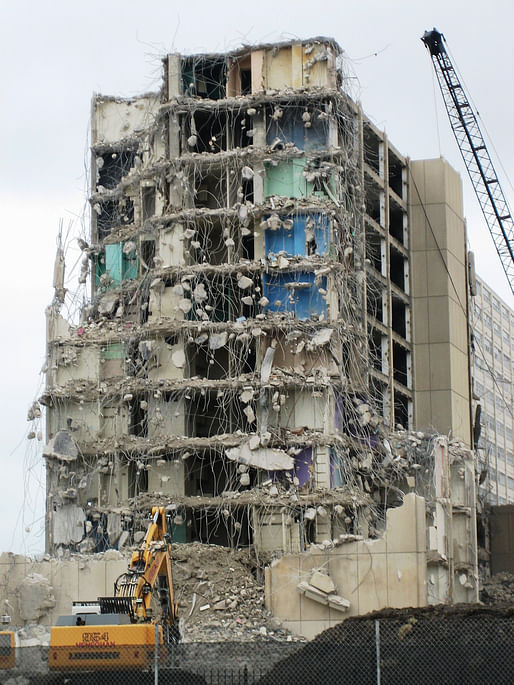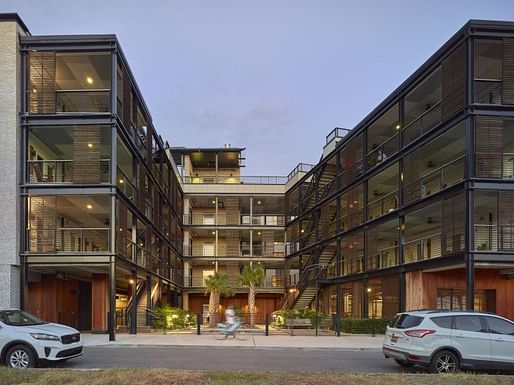

United States Representative Ilhan Omar has unveiled a new piece of legislation that seeks to reinvigorate public housing construction across the country by building 12 million new public and affordable housing units over the next decade.
The so-called “Homes for All Act” unveiled this week would bring a whopping $1 trillion in federal funding for the construction of these new units and would also establish a permanent federal funding steam to ensure housing affordability in the United States, according to The Star Tribune. As proposed, $800 million of the overall total would go toward the construction of 9.5 million new public housing units while the remainder will be used to finance a federal Housing Trust Fund used to fuel the construction of 2.5 million new affordable housing units by nonprofit and municipal entities, The Huffington Post reports.

A statement released by Omar’s office in support of the bill reads in part: “Every American deserves a safe and stable place to live, but unfortunately, our current free-market housing system is not meeting the needs of working families.”
The initiative comes on the heels of the Green New Deal for Public Housing Act, a public housing decarbonization and modernization initiative unveiled last week by Representative Alexandria Ocasio-Cortez and Vermont Senator Bernie Sanders based on research conducted by progressive think tank Data for Progress and the University of Pennsylvania’s McHarg Center and Socio-Spatial Climate Collaborative research centers.
Conceptually, Omar’s initiative provides a complimentary effort to the GND for Public Housing bill: Whereas the AOC and Sanders-backed bill offers something of a one-time fix for the myriad deferred maintenance and modernization needs of America’s public housing stock, Omar’s effort seeks to greatly expand the nation’s public housing overall, adding much-needed new units in an effort to ultimately solve the nationwide housing affordability crisis. The provision mandating that the federal government pay for the cost of maintaining and upgrading these facilities in the future represents a key expansion of the federal government’s responsibility for these properties that was avoided during previous generations to disastrous effects.

In addition, Omar’s bill would also establish a $200 billion Community Control and Anti-Displacement Fund that could “provide grants to local governments for the purposes of combating gentrification and neighborhood destabilization,” Citylab reports. The fund would help coordinate the federal government’s home-building plans with anti-displacement efforts so that some of the mistakes made during the Urban Renewal era, when low-income and disadvantaged neighborhoods were clear-cut to make way for new housing projects and highway infrastructure, would not occur again.
In addition, Omar’s bill would bring America closer to enshrining housing as a fundamental right for its residents, an aim Omar seeks to pursue with expanded safeguards against tenant discrimination. The Minnesota Representative told The Washington Examiner, “We will prohibit any discrimination against residents based on sexual orientation, gender, criminal history or immigration status,” adding, “Doing the Homes for All really gets us closer to having the America I imagined be realized and I’m really excited for the opportunity to now be in a position of influence to get that done.”
Omar’s office touts the bill as the first large-scale federal public housing building effort since the original New Deal, when President Franklin Delano Roosevelt’s National Industrial Recovery Act of 1933 and the United States Housing Authority Housing Act of 1937 initiated federal housing construction at a national scale.
Much of America’s public housing stock was built during and after the New Deal era, a process that extended into the late 1960s, with the New York City Housing Authority towers, the Minoru Yamasaki-designed Pruitt-Igoe complexes, and Chicago’s Cabrini-Green and Robert Taylor Homes being perhaps the most well-known public housing projects to come out of those efforts.
Many of the projects built before the Housing and Urban Development Act of 1968 embodied the “towers in a park” partii, a vision that soured as the nation’s inconsistent and incomplete federal housing efforts began to show their age amid widespread underinvestment. While initiated as mixed-income (though racially segregated) communities, over the decades, public housing eventually became synonymous with concentrated poverty, a phenomenon fueled by deferred maintenance, suburban housing development that overwhelmingly benefitted white Americans, the redlining of inner-city communities, and myriad other economic and social policies enacted by federal and local authorities across the country.
In time, the public housing tower typology was rejected in exchange for dispersed housing sites, more low-slung housing types, and a renewed emphasis on mixed-income communities. The Pruitt-Igoe complexes were famously imploded in 1971, signaling the popular death of federal public housing construction programs in the United States, as well as the so-called “death of Modernsim.”
Three years later, Congress authorized the creation of the Section 8 Program, a voucher-based system developed by the Department of Housing and Urban Development (HUD) that provides rental subsidies for eligible tenants so that they may be able to afford to live in privately owned, newly constructed, rehabilitated, or existing rental and cooperative apartment projects, according to the HUD website.
Omar’s proposal would revive America’s public housing construction sector following a 20-year hiatus in government home-building stemming from the creation of the HOPE VI program during the Clinton administration, an effort that saw affordable housing production handed off by the federal government to municipal entities and public-private partnerships.
What is the potential impact of the plan for the architecture and construction industries? Well, to put it plainly, 12 million homes over a decade represents a sizable increase in terms of housing construction, overall.
If distributed evenly over a decade, simple math dictates that 1.2 million homes could be built under the plan per year, more or less doubling the number of homes built annually in the United States. Recent statistics developed by the United States Census Bureau indicate that more than 1.4 million building permits were issued through October 2019, for example, while 1.256 million homes have been completed this year so far. For those searching for ways to implement burgeoning forms of housing design innovation that are taking shape across the field, the plan could represent a key funding mechanism that would allow some of these ideas to come to life. It could also potentially centralize some of these efforts within the federal housing development apparatus, a paradigm-shifting focus for the architecture industry in the U.S.

Since the plan focuses on building new units, it can be assumed that many ground-up and adaptive reuse projects could take shape, both on existing public housing properties and likely, on new sites. That shift could help to engender not only new housing, but a new generation of public realm improvements led by landscape architects, urban designers, and architects themselves that update the tired “towers in the park” and “garden city” approaches that remain prevalent and in need of renewed inspiration.
Further, as many of the existing public housing projects are located beside urban highway networks, there is perhaps an opportunity to re-think and repurpose these infrastructural spaces, as well, in order to keep true to the plan’s environmental justice agenda.
For architects, the initiative could help bolster the profession’s influence on matters of housing and community design overall, allowing it to wrest influence that has largely been ceded to the real estate industry by allowing designers to work with and for public sector entities on wide ranging projects that aim to bring longevity, dignity, and sustainability to the American housing tradition. This approach, because of its scale and publicly funded nature, could stand in opposition to the almost entirely profit-driven housing industry that exists today, fashioning a form of design innovation that places residents and sustainability at its core. With the nation staring down an impending senior housing crisis, cities shedding young families at an alarming rate, and homelessness impacting urban centers large and small, there is simply a lot of work in the housing arena to be done by architects. In addition, the plan’s permanent funding stream could help to ensure a long-term supply of this work for architects, designers, construction workers, fabricators, and installers generally speaking, as the newly built facilities are regularly maintained and upgraded over time.

The program’s construction focus could also serve as an instrument for modernizing and expanding beneficial labor and employment practices, as government projects often come along with stringent bidding and procurement requirements that include prevailing wage regulations, diversity and inclusion measures, and universal design specifications. Architects who work for government agencies like the federal General Services Administration represent some of the few professionals in the field who enjoy union representation; If the federal government organizes to design and build the proposed housing units itself, its safe to assume that the number of architects employed by the government could go up, a boon to those in search of greater unionization and better workplace standards, for example.
Of course, Omar’s proposal is just that, a proposal that has yet to be properly debated, legislated, and signed into law, but the vision it positions for the future of housing in America is perhaps one that architects should take note of.
14 Comments
As much as I like Omar she has missed the point entirely. The problem is economic: the so called "free market", heavily subsidized with public incentives, tax abatements, and special income tax benefits, chases profit at the expense of all else, and there is no profit in affordable housing. Throwing money at housing will not fix anything, it will just be another cesspool of privatization of what should be public services.
Her problem will be economic in a different way - "we can't afford it", the mantra of capitalists when it comes to anything public.
Aside from the fact that there is actually a surplus of some 8m housing units in the US, despite which there are over 1/2 million homeless.
The tight housing market in NYC has a vacancy rate of 3.63%, which equals about 79,000 units. The estimated number of homeless in NYC is 62,000.
Miles, similar numbers came up in Los Angeles.
"At least 36,000 homeless people live in the city of Los Angeles, but L.A. simultaneously has more than 41,000 empty housing units, according to a report released Tuesday by UCLA law students and a coalition of economic justice organizations."
The wealth of a few is made from the poverty of many.
this article is much more concerned with design than any politician I’ve seen. Starting with a price tag and not design is bad politics. Typical Democrat strategy
This is endemic to the system, not a political party (of which there is only one: the duopoly).
you kids are so naive its quite amazing.
lets get this straight. you work for say $60k a year, a bit of that goes to your hood and the Fed.
why are you supporting anything other than your grandmother who isn't working anymore? your Grandma did her time, support her.
why would you, someone who works 40+ hours a week, with your tax dollar pay for someone who doesn't work to live?
why would you let your tax dollars go to a government program every half ass Donald Trump would know how to abuse? [his pops taught him how]
are you kids really this ignorant? this is pure propaganda.
it is not your duty to help people who can't help themselves. people who don't help themselves, can't be helped.
The internet and library are free. Public education is free.
If you do not want to cooperate in this society - you fail.
Failure includes being homeless.
Home for all should mean, people who work.
If you don't work, you do not get to participate in our society.
FUCK YOU, YOU LAZY BASTARD! REALLY, I'M WRONG FOR YOU NOT TRYING TO CONTRIBUTE. YOU MIGHT BE A SOCIOPATH SUCKING THE LIFE OUT OF US REAL HARD WORKING 'MERICANS. AKA HOMELESS MOOCHES...
As a socialist, your failure to participate in humanity is your judgement. The rules are simple. Work hard, get a loan, buy a house. If you can't do that, you're a PARASITE.
try harder america!
PUBLISH HOUSING IS FOR PEOPLE WHO DON'T TRY.
^ written with near complete ignorance of reality including massive un- and underemployment (official statistics only count those collecting unemployment “benefits”, once those run out - or if you’re self-employed - you are not counted, and the official poverty level is based on food prices in 1965); major employers like Walmart, Amazon, Uber, etc. whose employees depend on public assistance in order to survive on their shit pay (WalMart actually has a specialist in each store to help staff apply for food stamps, Medicaid, and housing assistance); seniors who worked their entire lives and can’t afford to live without working; unaffordable health care; and in general a system designed to penalize everyone not at the top.
The high cost of housing is driven by banks and developers based on how much they can possibly squeeze out of everything. You’re trained to be an analytical designer, open you eyes and stop being such an ignorant gullible dumbass.
hmm....now I have to give a real response....no, miles, if you don't work, if you don't produce, you do not get, you do not get stuff, you do not get a home. if you do not subscribe to the traditional nuclear family, guess you're on your own.... a true socialist works their balls off....retirement is a bullshit idea your generation invented. you work, you die. end of story.
In order to work you need the opportunity to work, and not just some shitty part-time minimum wage job with no benefits that further enriches the oligarchy. Half the population does not have a savings account or a thousand dollars for an emergency. They work, but with no reward other than bare survival.
.
Listen to all this all you douchebags
It's time that we laid down the law
We're tired of taking your shit
And we ain't 'gonna take it no more
Be prepared to fight and die
So that we may be free
And if you don't like it here
Than pack your shit and leave
Our forefathers died in war
So that you could live better
We at least owe it to them
To keep the stars and stripes forever
Planting bombs in planes
Blowing up our ships
Kill our kids and woman
Find these dickless slobs
Hang them by the scrotum
Lets end the terrorism
You think yourself a god
Would follow to the death
A spineless yellow faggot
A bunch of stinking slobs
Hiding behind masks
Show yourself 'ya maggot
The trillion dollars Omar asks for, btw, is our current federal budget deficit, after two years of tax "reforms."
Anybody know how much we now have to pay to service this debt? What else might have been financed (housing?)?
The debt is bullshit. It is essentially a measure of how much money the government creates to run the economy. It never has to be "paid back". If you paid back 'the debt' the economy would collapse.
A large part of this is the Federal Reserve and the privatization of the creation of money. Another is the "we can't afford it" bullshit, which if you haven't noticed only applies to social programs and never to the military, corporate subsidies, tax breaks for the uber rich, etc.
Block this user
Are you sure you want to block this user and hide all related comments throughout the site?
Archinect
This is your first comment on Archinect. Your comment will be visible once approved.